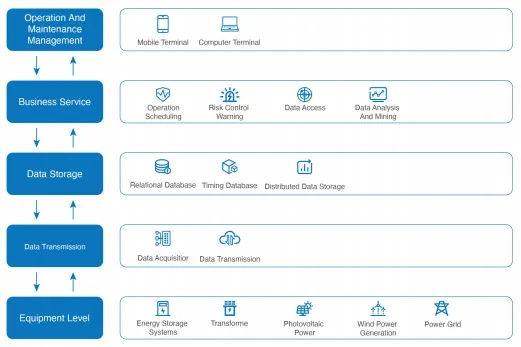
Jul . 03, 2025 13:58 volver a la lista
Electrical Energy Management System for Electric Vehicle Charging
The rapid adoption of electric vehicles (EVs) has transformed the automotive industry, but it also presents new challenges for power grids and energy consumption. Efficiently managing electricity demand during EV charging is critical to prevent grid overloads, reduce costs, and promote sustainability. This is where an electrical energy management system (EEMS) comes into play. By integrating advanced technologies like smart algorithms, real-time monitoring, and energy management system battery storage, these systems optimize energy use, balance loads, and ensure seamless EV charging experiences. In this article, we explore how these systems work, their benefits, and their role in shaping a greener future.

Understanding the Role of Energy Management Systems in EV Charging
An energy management system (EMS) is the backbone of efficient EV charging infrastructure. It acts as a digital conductor, coordinating energy flow between the grid, renewable sources, and EVs. By analyzing real-time data such as electricity prices, grid load, and user preferences, the EMS schedules charging sessions during off-peak hours or when renewable energy generation (e.g., solar or wind) is at its peak. This not only reduces strain on the grid but also lowers energy costs for consumers.
For instance, during periods of high demand, the energy management system can temporarily pause non-essential charging or shift it to times when electricity is cheaper and more abundant. Additionally, EMS platforms often include user-friendly interfaces, allowing EV owners to set charging priorities, track energy usage, and even sell surplus energy back to the grid. This level of control fosters a sustainable energy ecosystem while keeping costs predictable.
Integrating Battery Storage with Energy Management Systems
Pairing an energy management system battery storage solution with EV charging infrastructure unlocks unprecedented flexibility. Battery storage systems store excess energy generated from renewables or drawn during low-demand periods. When combined with an EMS, this stored energy can be strategically deployed to power EV chargers during peak hours or grid outages.
For example, a solar-powered charging station equipped with energy management system battery storage can store sunlight-generated electricity during the day and use it to charge EVs at night. This reduces reliance on fossil fuels and ensures uninterrupted service. Moreover, batteries can act as buffers, absorbing sudden surges in demand and preventing grid instability.
The synergy between sistemas de gestión de energía and battery storage also supports bidirectional energy flow. Modern EVs with vehicle-to-grid (V2G) capabilities can discharge stored energy back into homes or the grid during emergencies, turning EVs into mobile power banks. This innovation is only possible with a robust EMS coordinating the complex energy exchanges.
The Advanced Capabilities of Electrical Energy Management Systems
An electrical energy management system takes traditional EMS capabilities a step further by incorporating machine learning, IoT connectivity, and predictive analytics. These systems don’t just react to current conditions—they anticipate future scenarios. For instance, by analyzing historical data and weather forecasts, an EEMS can predict solar generation levels and adjust charging schedules accordingly.
Key features of an electrical energy management system include:
Dynamic Load Balancing: Distributes energy across multiple chargers to avoid overloading circuits.
Demand Response Integration: Automatically adjusts energy use in response to utility signals or pricing changes.
Carbon Footprint Tracking: Provides insights into the environmental impact of charging activities.
These systems are particularly valuable for commercial settings like charging hubs or fleet depots, where managing dozens of EVs simultaneously requires precision. By optimizing energy use, businesses can slash operational costs and meet sustainability goals.
FAQs About Electrical Energy Management Systems and Battery Storage
How Does an Energy Management System Optimize EV Charging?
An energy management system uses real-time data analytics to schedule charging during low-demand periods, prioritize renewable energy sources, and prevent grid overloads. By intelligently allocating power, it reduces electricity costs and ensures efficient energy use.
What Are the Benefits of Integrating Battery Storage with an Energy Management System?
Combining energy management system battery storage ensures a reliable power supply, even during outages. It stores surplus renewable energy for later use, reduces peak-time grid dependence, and enables bidirectional energy flow, turning EVs into backup power sources.
How Does an Electrical Energy Management System Enhance Efficiency?
An electrical energy management system employs predictive algorithms to forecast energy needs and adjust charging schedules proactively. It balances loads dynamically, integrates renewables seamlessly, and provides actionable insights to minimize waste.
Can Energy Management System Reduce My Electricity Costs?
Absolutely! By leveraging off-peak rates, maximizing renewable energy use, and avoiding demand charges, an energy management system can cut your electricity bills by up to 40%. Battery storage further enhances savings by reducing grid reliance during expensive peak hours.
Is Energy Management System Reliable During Power Outages?
Yes. With energy management system battery storage, your EV charging setup can operate independently during outages. The stored energy powers chargers, ensuring uninterrupted service while supporting your home or facility’s critical needs.
The future of EV charging lies in smart, adaptive systems that harmonize energy supply, storage, and demand. An electrical energy management system paired with energy management system battery storage offers a holistic solution to today’s energy challenges. Whether you’re an individual EV owner or a business managing a fleet, these systems deliver cost savings, reliability, and environmental benefits. By investing in this technology, you’re not just powering vehicles—you’re driving the transition to a sustainable energy future.
-
Smart Grid Management for Rural Electrification
NoticiasJul.03,2025
-
Energy Management System Battery Storage for Renewable Integration
NoticiasJul.03,2025
-
Energy Control Systems in Public Transportation Networks
NoticiasJul.03,2025
-
Electrical Energy Management System for Electric Vehicle Charging
NoticiasJul.03,2025
-
BMS Energy Retrofitting for Aging Infrastructure
NoticiasJul.03,2025
-
Adaptive Energy Control Systems for Weather Variability
NoticiasJul.03,2025























